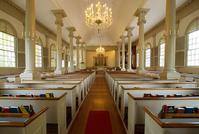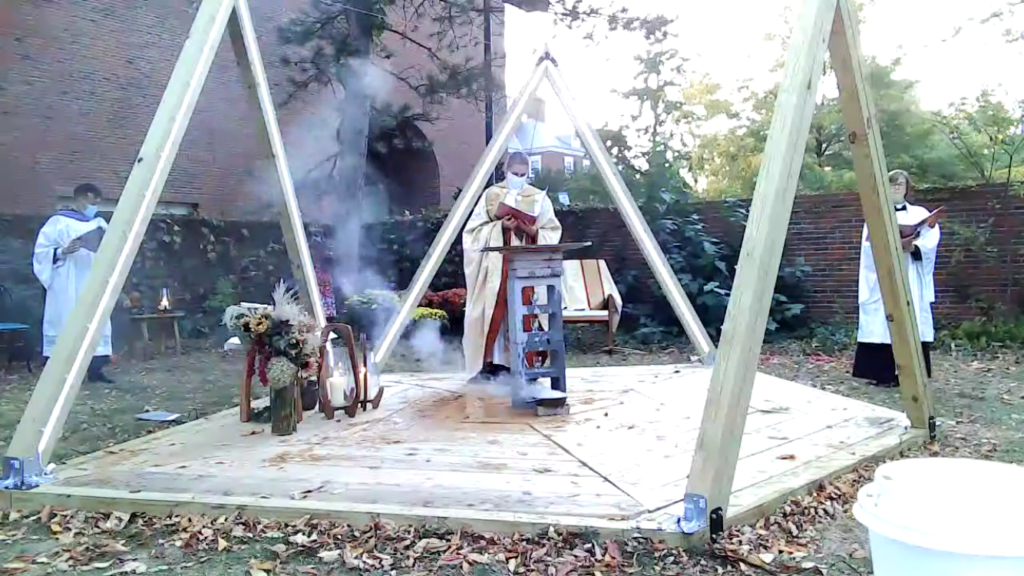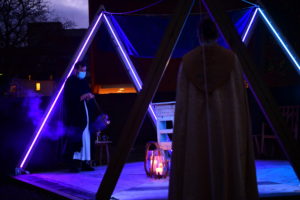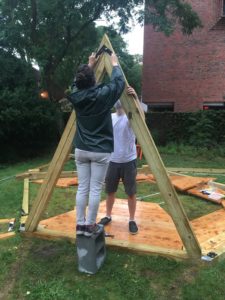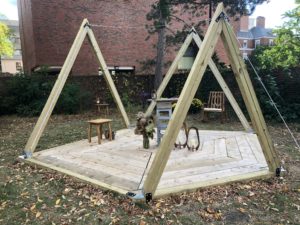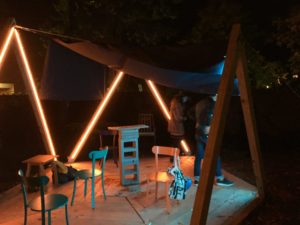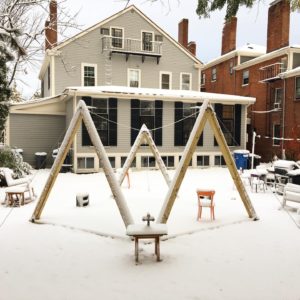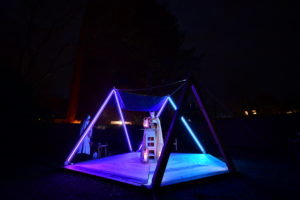Harvard’s Liturgical Tent Structure
Students at Harvard University worship at Christ Church Cambridge, a Revolutionary War-era church in the stark, puritan architectural tradition.
“One evening we were meeting,” said Rita Powell, Episcopal Chaplain at Harvard, “and looking at a dark, empty church and thinking about what could we do with the space to make it feel more close, more cozy, more devotionally inspired in some ways. We started to think about what intervention we could make in the space. It would have to be something that we could set up and take down every week.”
Powell knew that whatever the route they chose, the change to their space needed to be substantial. From that mindset, and through conversation and prayer, Powell and company landed on the idea of a tent.
“One of the great things about being a chaplain in a place like Harvard is that you have this huge resourced community,” said Powell. “You have students in the undergraduate group but you also have students in the graduate schools and in the greater community who are connected either to Harvard or to the church.”
Powell knew just the person who could help – choir member and doctoral graduate, Matthew Gin. Gin studied medieval ephemeral architecture, a seemingly perfect candidate to be involved in the new tent venture.
“As soon as I had the idea of a tent,” said Powell, “I thought, ‘Oh my gosh Matt Gin is going to be the one.”
Gin gave a presentation about ephemeral structures on the inside (as well as outside) of church, and their historic precedent. People were intrigued.
“We started realizing that we were asking a bigger question than the first one,” said Powell. “The first one had just been how we could enhance our worship space. But then we realized that we were talking about how do we make a home in a structure that we have inherited. It was a big question, one that the whole church might be asking, and certainly one that young adults in church are asking.”
Powell also read a colleague’s essay about the structures of the church in some way obscuring the gospel, and that perhaps a different kind of structure was required. The essay posited that permanent long-term structures obscured something about the nature of the Gospel as ephemeral.
“The incarnation itself had tent imagery,” said Powell, “and that’s when we realized we’re onto something.”
“Unlike so many plans that got ruined by COVID,” said Powell, “this was a plan that suddenly made even more sense and felt even more urgent.”
The focus shifted from an indoor structure to an outdoor structure.
“We began to design a structure,” said Powell, “a kind of tent-chapel for the outdoors.”
Powell then met Benjamin Bromberg Gaber through Matt Gin. Bromberg Gaber, a devout Jewish architecture student, was interested in the tent project – after all, tents hold their own significance in the Jewish faith traditions. Soon after, Powell and company received a grant to build the structure. And then COVID-19 hit.
Powell, with the help of Matthew Gin, Benjamin Bromberg Gaber, and Meredith Wade, put together an idea for just what their structure should and could be.
“We wanted to build something that was in conversation with the tradition but at the same time something that was in dialogue by being different,” said Powell. “There is a beauty to an aesthetic that wants to call attention to God’s creation more than the work of human hands.”
They knew that they wanted the structure to be minimalist and modern, as well as modular, and so they ended up with a triangular design which referenced the classical arch shape as well as the trinity.
They knew the liturgical and worship possibilities for the outdoor structure, but they wanted it to also be more accessible to others who may not otherwise attend a worship service. That’s when they thought of theater.
“The plan is to move it (the tent) around for a theater production that we’re working on in May,” said Powell. “Originally we had imagined that this would be a part of the year of programming for the Chaplaincy, but not the only thing.”
“In the designed structure,” said Powell, “it has doors and lights, and ways we can interact with it in the same way that we can interact liturgically with a church. We can have a place that we can build an altar on Sundays. It’s really felt like we’re in a church that’s open to the garden, and that’s been really interesting.”
“Ultimately, we were so excited to be creating a church that had only doors, no walls or ceiling,” said Powell, “We have created a different way of dwelling.”
In that challenge, that call to find a new way to inhabit existing structures, lies both the essence of young adult ministry and a witness to the wider church about the creative possibilities that lie within change.

